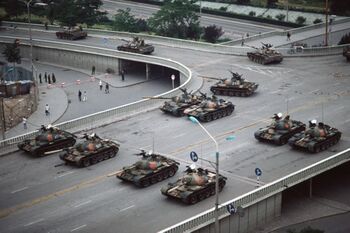1997 Daekanese coup d'etat: Difference between revisions
No edit summary |
No edit summary |
||
| Line 1: | Line 1: | ||
{{Infobox military conflict | {{Infobox military conflict | ||
| conflict = | | conflict = 1997 Daekanese coup d'etat | ||
| partof = | | partof = | ||
| image = Tanks in Tayeong.jpeg | | image = Tanks in Tayeong.jpeg | ||
Revision as of 13:57, 20 November 2020
| 1997 Daekanese coup d'etat | |||||||
|---|---|---|---|---|---|---|---|
 Type 76 tanks of the 10th Mechanised Division in downtown Tayeong | |||||||
| |||||||
| Belligerents | |||||||
|
Supported by: |
Supported by: | ||||||
| Commanders and leaders | |||||||
|
|
| ||||||
| Strength | |||||||
| 30,000 DPA and MSS troops | 12,000 Tayeong Guards | ||||||
| Casualties and losses | |||||||
| 2 killed, 6 wounded | 8 killed, 15 wounded | ||||||
| 5 civillians killed, dozens wounded | |||||||
The 1997 Daekanese coup d'etat, also known as the July Coup, the Cadre Coup or the Restoration Revolution, was the successful seizure of power in Daekan by the Restoration Committee and its allied forces, against Premier Kwon Jung-Hoon. The coup lasted two days with minimal fighting, which nevertheless resulted in both military and civillian casualties.
The coup was orchestrated by the Restoration Committee, a group of Party, Ministry of State Security and Daekanese People's Army officials that had been alienated by Premier Kwon's reversal of his predecessor's (Maeng Song-Hun) Hyeogsin reforms, as well as the catastrophic fallout brought about from Kwon's aggressive foreign policy, specifically the involvement in the Esgonian Civil War. The Restoration Committee was made up of reformists that had been dedicated to Premier Maeng's policies of political and economic liberalisation, as well as opening up Daekan to the west. As such, the Committee became popularly known as the Maengist Cadre.